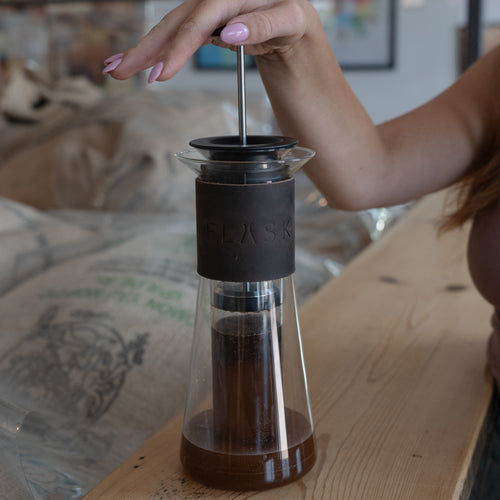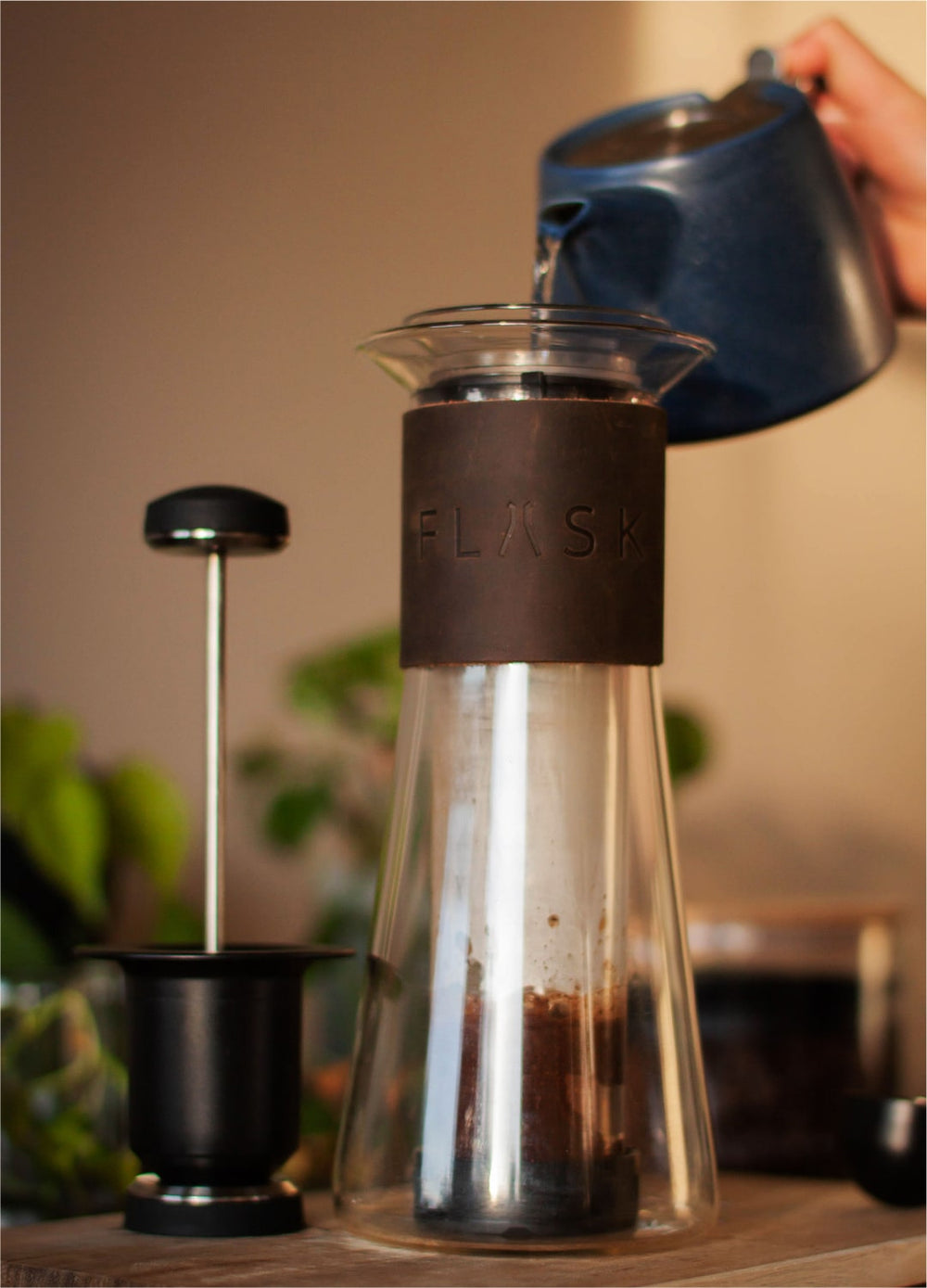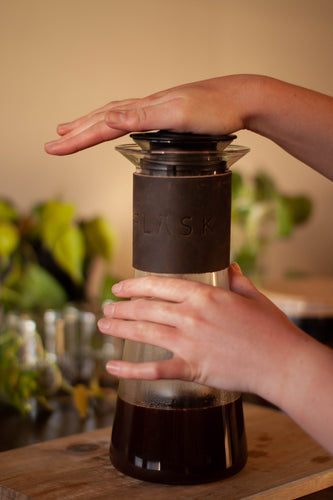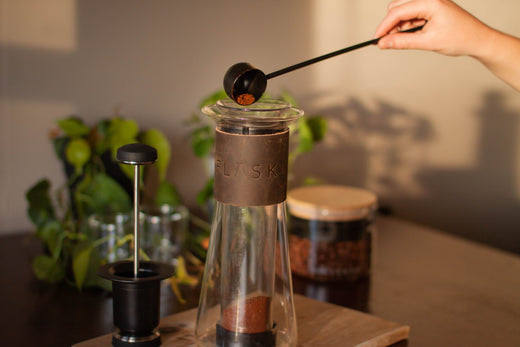Making great cup of coffee at home begins with choosing the right brewing method. With so many different types of coffee makers and machines available today, finding your perfect match can feel overwhelming.
Whether you're diving into the world of coffee or simply exploring different types of coffee machines for your morning routine, choosing the right brewing method can feel overwhelming.
From simple manual brewers to sophisticated automated systems, each type offers unique benefits.
How Many Types of Coffee Makers & Machines Are There?
The world of different coffee makers has expanded dramatically in recent years. From traditional manual brewers to sophisticated automated machines, there are now more ways than ever to craft your perfect cup. We can broadly categorize coffee makers into manual brewers (like pour-overs and French presses), semi-automatic machines (like drip coffee makers), and fully automatic systems (like bean-to-cup machines).
What Are the Different Types of Coffee Makers?
Let's dive into the types of coffee brewers that give you hands-on control over your brewing process. These manual methods let you fine-tune every aspect of your coffee making, from water temperature to brewing time, resulting in a more personalized cup.
1. Flask Coffee Press
The Flask stands out among coffee maker types for its innovative approach to the classic French press design. What sets it apart is its unique double-wall brewing chamber that maintains consistent temperature throughout extraction, while its proprietary brew valve prevents over-steeping – a common issue with traditional French presses.
The real game-changer is Flask's cleanup system. While most press-style brewers leave you with a messy cleanup, Flask's removable chamber lets you eject spent grounds with minimal fuss. Simply press, twist, and dispose – no scraping or rinsing required. The entire unit is dishwasher safe once you remove the leather wrap.
Pros:
- Incredibly easy cleanup compared to traditional presses
- Double-wall insulation maintains ideal brewing temperature
- No over-extraction thanks to the separation valve
- Clear brewing chamber lets you watch the process
- Elegant design that looks great on any counter
Cons:
- Higher price point than basic French presses
- Takes up more storage space than simpler brewers
2. Pour Over
Pour over brewing has become a cornerstone of specialty coffee culture, and for good reason. This method gives you complete control over every aspect of the brewing process, from water temperature to pour speed and pattern. The result is a clean, bright cup that highlights the subtle flavors in your beans.
The process involves placing a filter in a cone-shaped dripper, adding freshly ground coffee, and carefully pouring hot water over the grounds in a circular motion.
This manual method requires attention and practice but rewards you with exceptional clarity in your cup.
Read next: french press vs pour over
Pros:
- Excellent flavor clarity
- Complete control over brewing variables
- Minimal equipment needed
- Easy cleanup
- Affordable entry point
Cons:
- Requires practice to master
- Takes more time than automated methods
- Usually limited to making 1-2 cups at once
- Requires separate kettle (preferably gooseneck)
3. French Press
This classic brewing method has been a staple in coffee enthusiasts' kitchens for decades when it comes to making a cup of coffee. The French press relies on a simple immersion brewing process where coarsely ground coffee steeps in hot water before being separated by a mesh plunger. While it produces a full-bodied cup with rich oils and intense flavor, traditional French presses come with notorious cleanup hassles.
This is where Flask's innovative design really shines compared to conventional French presses. While traditional models leave you dealing with messy grounds that are difficult to clean out, Flask's removable chamber system transforms what was once a dreaded cleanup process into a simple twist-and-dump operation.
Read next: french press vs drip or check out some French press alternatives.
Pros:
- Full-bodied, rich flavor
- Simple brewing process
- No paper filters needed
- Great for brewing multiple cups
- Portable and durable
Cons:
- Traditional models are difficult to clean
- Can leave sediment in your cup
- Risk of over-extraction if left too long
- Requires coarse grinding consistency
4. AeroPress
The AeroPress has gained a devoted following for combining elements of immersion and pressure brewing in a portable package. It uses air pressure to push water through coffee grounds, creating a concentrated brew that can be used as a base for various coffee drinks.
Unlike the bulkier French press or the more delicate pour-over setups, the AeroPress is incredibly travel-friendly and nearly unbreakable. Its design allows for both traditional and inverted brewing methods, giving coffee enthusiasts room to experiment with different techniques.
Read next: Aeropress vs French press or check out an Aeropress alternative
Pros:
- Extremely portable
- Quick brewing time
- Easy cleanup
- Versatile brewing options
- Durable construction
Cons:
- Only brews one cup at a time
- Requires special circular filters
- Plastic construction may not appeal to everyone
- Learning curve for optimal technique
5. Pour Over Carafe
Pour over carafes like the Chemex combine the precision of manual brewing with larger capacity. These brewers use the same principles as single-cup pour overs but scale up for brewing multiple servings. The process requires careful attention to pouring technique and timing, but rewards you with exceptional clarity and clean flavors.
The key difference from single-cup pour overs lies in managing the larger coffee bed and longer brew times. This makes maintaining consistent extraction more challenging but also allows you to brew coffee for multiple people at once.
Pros:
- Brews multiple cups at once
- Excellent flavor clarity
- Beautiful design
- No electricity needed
- Great for entertaining
Cons:
- Requires careful technique
- More expensive than basic pour overs
- Glass construction can be fragile
- Longer brew time than automated methods
6. Cold Brew
Cold brew has revolutionized how we think about iced coffee, offering a smooth, less acidic alternative to hot-brewed coffee. This method involves steeping coarsely ground coffee in cold water for 12-24 hours, producing a concentrated brew that can be diluted with water or milk.
The extended steeping time extracts different compounds than hot brewing, resulting in a naturally sweet, smooth taste without bitterness. While the process is simple, it requires planning ahead and storing the brew properly.
Pros:
- Smooth, low-acid flavor
- Makes coffee concentrate that keeps for days
- Great for iced drinks
- Simple process
- No special equipment needed
Cons:
- Long preparation time
- Takes up refrigerator space
- Large batches required
- Different flavor profile than hot coffee
7. Chemex
The Chemex brings artistry to coffee brewing, with its distinctive hourglass shape and thick paper filters. This pour over carafe combines elegant design with excellent filtration to produce an exceptionally clean cup. The thicker filters remove more oils than standard paper filters, resulting in a bright, nuanced brew that showcases the subtle flavors in your beans.
What sets the Chemex apart is its ability to brew larger quantities while maintaining the precision of manual brewing. The thick paper filters and special design create a slower flow rate that helps achieve optimal extraction, though this does require some patience and practice.
Pros:
- Produces extremely clean, bright coffee
- Beautiful design that doubles as a serving vessel
- Excellent for entertaining
- No metallic or plastic taste
- Built-in heat retention with wooden collar
Cons:
- Requires special Chemex filters
- Glass construction needs careful handling
- More expensive than basic brewers
- Longer brew time due to thick filters
8. Ibrik (Turkish Coffee Maker)
One of the world's oldest brewing methods, the Ibrik (or cezve) creates intensely flavored, unfiltered coffee using an extremely fine grind. This small pot with a long handle is traditionally made of copper or brass and used to brew coffee directly on a heat source.
The process involves combining finely ground coffee with water and optional sugar, then slowly heating until it foams up without boiling over. This method produces a thick, strong brew with grounds that settle at the bottom of your cup.
Pros:
- Creates uniquely rich, intense flavor
- Steeped in tradition and ceremony
- Compact size
- Works on any heat source
- No filters needed
Cons:
- Takes practice to master
- Coffee grounds in final cup
- Small serving size
- Requires very fine grind
9. Siphon (Vacuum Pot)
For those who love the theater of coffee brewing, the siphon offers an impressive show. This vacuum coffee maker uses heat and pressure differences to create a clean, full-flavored brew. Water rises from the bottom chamber to the top through vacuum pressure, mixes with the grounds, then drains back down as it cools.
While it might seem complex way to make a cup of coffee, the siphon actually provides excellent temperature control and full immersion brewing, resulting in a clean cup with full flavor development. However, it requires more setup and attention than simpler methods.
Pros:
- Fascinating brewing process
- Excellent temperature control
- Clean, full-flavored result
- Great conversation piece
- No paper filters needed
Cons:
- Complex setup and cleanup
- Fragile glass components
- Requires special heat source
- Time-consuming process
10. Moka Pot
This stovetop coffee maker produces a strong, espresso-like brew using steam pressure. Popular in Europe and Latin America, the moka pot forces hot water up through ground coffee to produce a concentrated drink that's stronger than drip but not quite espresso.
While the Flask offers a cleaner cup with easier cleanup, the moka pot remains popular for those seeking a strong brew without investing in an espresso machine. Its durable construction and simple mechanism make it a reliable choice for strong coffee lovers.
Pros:
- Makes strong, rich coffee
- Durable construction
- Works on most stovetops
- No electricity needed
- Portable
Cons:
- Can produce bitter coffee if not used correctly
- Requires careful heat management
- Not dishwasher safe
- Limited capacity
11. Percolator
The percolator evokes nostalgia for many coffee drinkers, with its characteristic bubbling sound and ability to brew large quantities. This brewing method continuously cycles hot water through grounds using a simple pump action, producing a strong, hot brew that's perfect for serving crowds.
While modern coffee makers like Flask have improved on the percolator's tendency to over-extract, these classic brewers still have their place, especially for outdoor cooking and large gatherings. Their durable construction and simple operation make them reliable workhorses.
Pros:
- Brews large quantities
- Keeps coffee hot
- Durable construction
- Great for camping
- Simple operation
Cons:
- Can easily over-extract
- Less control over brewing
- Sometimes produces bitter coffee
- Basic flavor profile
What Are the Different Types of Coffee Machines?
Moving from manual methods to automated systems, coffee machines offer convenience and consistency for daily brewing. These range from simple drip makers to sophisticated automated systems that can craft specialty drinks at the touch of a button.
12. Drip Coffee Machine
As the most common type of coffee machine in American homes, drip coffee makers prioritize convenience and reliability. They automate the hot water dispensing process, maintaining consistent temperature and timing for reproducible results.
Modern drip machines have evolved significantly, with features like programmable brewing times, temperature control, and even built-in grinders. However, they still can't match the precision of manual brewing methods like Flask for those seeking maximum flavor clarity.
Pros:
- Easy to use
- Programmable features
- Brews multiple cups
- Keeps coffee warm
- Low maintenance
Cons:
- Less control over brewing variables
- Coffee can taste flat
- Heating plate can burn coffee
- Regular cleaning needed
13. Espresso Machine
Espresso machines bring café-quality drinks home by forcing hot water through finely ground coffee under high pressure. These machines range from basic manual models to sophisticated automatic versions that can steam milk and program drink recipes.
While they produce authentic espresso drinks, these machines require significant investment in both money and learning curve. The Flask offers an easier way to make strong coffee without the complexity of espresso brewing.
Pros:
- Makes authentic espresso
- Allows for milk-based drinks
- Customizable results
- Professional quality possible
- Wide range of drink options
Cons:
- Expensive investment
- Requires practice
- Regular maintenance
- Takes up counter space
- Needs special grinder
14. Capsule Coffee Machine
Capsule machines prioritize convenience above all when making a cup of coffee, offering quick, consistent coffee at the push of a button. These systems use pre-portioned pods of ground coffee to brew individual servings, eliminating the need for measuring or grinding.
While they can't match the flavor complexity achieved with Flask or other manual brewers, capsule coffee maker machines serve a purpose for those prioritizing speed and simplicity. However, the environmental impact of disposable pods has become a growing concern.
Pros:
- Extremely convenient
- Consistent results
- No measuring needed
- Quick brewing
- Easy cleanup
Cons:
- Environmental impact
- Expensive per cup
- Limited coffee options
- Less flavorful brew
- Dependent on pod availability
15. Bean-to-Cup Machine
These all-in-one machines handle every step from grinding fresh beans to brewing your coffee. They offer the convenience of automated brewing while maintaining the benefits of freshly ground beans, though they can't match the precision of manual grinding and brewing.
Bean-to-cup machines typically include milk frothing systems and can make various coffee drinks automatically. However, their complexity means more potential points of failure and higher maintenance needs.
Pros:
- Fresh ground coffee
- Multiple drink options
- Automated convenience
- Consistent results
- One-touch operation
Cons:
- Expensive investment
- Complex maintenance
- Large footprint
- Less control over variables
- Noisy operation
16. Super-Automatic Machine
The ultimate in coffee automation, super-automatic machines handle everything from grinding to milk frothing with minimal user input. They can store multiple user preferences and create a wide range of specialty drinks automatically.
While convenient, these machines remove much of the craft from coffee making. The Flask offers a more engaging brewing experience while still delivering excellent results with minimal fuss.
Pros:
- Fully automated operation
- Multiple user profiles
- Consistent drinks
- Minimal training needed
- Various drink options
Cons:
- Very expensive
- Complex repairs
- Less connection to process
- Large counter footprint
- Regular maintenance required
Key Takeaways About Different Kinds of Coffee Makers
After exploring the wide world of coffee brewing methods, it's clear that each system offers unique benefits and tradeoffs. Manual brewers like pour-overs and traditional French presses give you maximum control but require more effort. Automated machines offer convenience but often sacrifice some quality and connection to the brewing process.
The Flask press coffee maker strikes an impressive balance between these extremes. It delivers the rich, full-bodied brew of a French press while solving the classic cleanup problem that has frustrated coffee lovers for decades. Two key advantages make it stand out:
- The innovative double-wall brewing chamber and separation valve ensure optimal extraction without bitterness, delivering consistently excellent coffee without the complexity of high-end machines.
- The revolutionary cleanup system transforms what was traditionally the most dreaded part of manual brewing into a simple, mess-free process that takes seconds rather than minutes.
Whether you're upgrading from a basic drip machine or looking to simplify your manual brewing routine, Flask offers an elegant solution that doesn't compromise on coffee quality. It's the rare coffee maker that actually delivers on its promises, making great coffee more accessible without sacrificing the engagement that makes manual brewing so rewarding.
The choice of coffee maker ultimately depends on your priorities - convenience, control, capacity, or cost. But for those seeking excellent coffee without the cleanup hassle, Flask represents a genuine innovation in coffee brewing technology.




